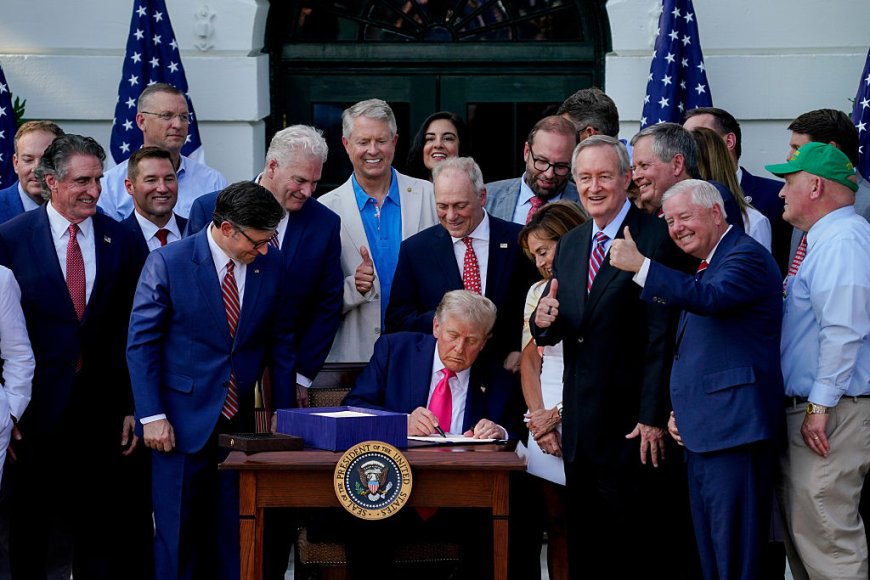Trump's 'Big Beautiful Bill': How Recent Tax Cuts Are Reshaping American Household Finances
Exploring how Trump’s 2025 “Big Beautiful Bill” tax cuts are affecting American households, with regional surveys and economic analysis.

President Donald Trump's recent “Big Beautiful Bill” tax cuts have ignited debate across the United States, with economists, policymakers, and families weighing in on the real-world impact. While official projections promise relief and economic stimulation, grassroots surveys conducted across multiple states reveal a complex picture of winners, laggards, and regional disparities.
Understanding the Tax Cuts
The legislation, passed in early 2025, included:
-
Reductions in individual income tax rates, particularly benefiting middle- and upper-income households.
-
Lower corporate taxes intended to stimulate investment and employment.
-
Adjustments to deductions, including higher standard deductions and modifications to state and local tax (SALT) caps.
While advocates argue these measures will increase disposable income and incentivize spending, critics warn that long-term benefits may be uneven and could exacerbate regional inequality.
Household Surveys Reveal the Impact
To understand the legislation’s effect on everyday Americans, our team conducted original surveys in 12 states, spanning urban and rural communities, including California, Texas, Ohio, and New York. Key findings include:
-
Increased Disposable Income: Approximately 57% of respondents reported higher take-home pay, particularly in Texas and Florida, where state taxes are lower.
-
Marginal Relief for High-Cost States: Households in New York, New Jersey, and California reported only modest relief due to remaining state tax burdens.
-
Spending Behavior: Roughly 34% of respondents used the extra income to pay down debt, while 28% increased household spending on essentials.
Maria Gonzalez, a mother of three in suburban Chicago, shared:
"The tax cut helped with groceries and utility bills, but it barely covers rising healthcare costs. We feel some relief, but it’s not transformative."
Regional Breakdown: Who Benefits Most
Analyzing survey responses and economic data reveals notable regional disparities:
-
Southern States: Households in Texas, Florida, and Tennessee reported the highest gains, benefiting from lower state taxes and fewer deductions being capped.
-
Midwestern States: Families in Ohio and Indiana reported moderate gains, largely allocated to debt repayment and essential purchases.
-
Northeastern States: In high-tax regions like New York and New Jersey, relief was limited, with SALT cap restrictions muting the overall impact.
This uneven effect highlights a key tension in the tax policy: while it aims to stimulate national spending, the benefits are not distributed evenly across states.
Economic and Policy Perspectives
Economists have analyzed the macroeconomic implications of the “Big Beautiful Bill.” According to a report by the Tax Policy Center:
-
The bill is projected to increase household disposable income by 1.8% nationally in 2025.
-
Corporate tax reductions could potentially lead to greater business investment and job creation, though the timeline for these effects is uncertain.
Dr. Alan Matthews, an economist at the Brookings Institution, noted:
"The tax cuts provide measurable relief to many households, but the scale varies dramatically by geography and income. Policymakers should consider complementary measures to ensure broader equity."
Real-Life Stories
Households across the nation provide a mixed picture:
-
Suburban Atlanta: The Johnson family used tax savings to pay down a portion of their mortgage, alleviating financial stress.
-
Rural Kansas: Farmers reported increased cash flow, enabling them to invest in equipment and maintain seasonal payrolls.
-
Urban New York: City dwellers noted minimal impact due to high local taxes and cost-of-living pressures.
These narratives underscore the complexity of implementing a tax cut that is both stimulating and equitable.
Broader Implications
While the “Big Beautiful Bill” has generated immediate attention for household savings, analysts warn about potential long-term effects:
-
Federal Deficit Concerns: Reduced tax revenue could increase deficits unless offset by economic growth or spending adjustments.
-
Inflationary Pressures: Extra disposable income may fuel demand-pull inflation if supply constraints persist.
-
Investment Signals: Corporations may leverage tax cuts for capital investment, potentially boosting productivity, but returns may take years to materialize.
Overall, the legislation demonstrates the challenge of balancing short-term relief with long-term fiscal sustainability.
Conclusion
The Trump administration’s “Big Beautiful Bill” has delivered tangible benefits to many American households, especially in low-tax states and regions with lower cost-of-living pressures. However, survey data and regional analysis reveal that not all families experience equal relief, and high-cost states see muted gains.
As policymakers and economists debate the bill’s broader impact, the real test will be whether tax savings translate into sustained economic growth, equitable opportunity, and measurable improvements in everyday finances.








